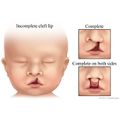Condition Basics
What is cleft lip?
Cleft lip is a treatable birth defect. It happens when the tissues of the upper jaw and nose don't join as expected during fetal development. This causes a split (cleft) in the lip.
A cleft lip may be complete or incomplete. With either type, it may involve one or both sides of the upper lip and rarely occurs in the lower lip. Cleft lip often occurs with cleft palate. Cleft palate and cleft lip are the most common birth defects of the head and neck.
A cleft lip usually doesn't cause health problems. Surgery can be done to fix the split.
What causes it?
Doctors don't know what all of the causes are. But your baby may be more likely to have a cleft lip if:
- You use certain medicines while you're pregnant.
- You use alcohol or drugs while you're pregnant.
- You or a household member smokes while you're pregnant.
- You are exposed to radiation or infections while you're pregnant.
- Either birth parent has a family history of cleft lip.
It's important to take good care of yourself before and during your pregnancy so that your baby will be as healthy as possible.
People who have a family history of cleft lip may want to think about genetic counseling. It can help you understand your chances of having a child with a cleft lip.
What are the symptoms?
You'll notice a split in the baby's lip. It's easy to see right at birth.
A baby with a cleft lip typically doesn't have any problems feeding. But a baby who has both a cleft lip and a cleft palate may have feeding problems.
How is it diagnosed?
Cleft lip is usually diagnosed at birth. Shortly after birth, the baby will have a physical exam. The doctor will look inside your baby's mouth to see if there is also a cleft palate. Sometimes a fetal ultrasound during pregnancy can detect a cleft lip. But an ultrasound doesn't always find the problem.
How is cleft lip treated?
Surgery can fix a cleft lip. Before surgery, a baby may wear a mouth support (such as a dental splint) or a soft dental molding insert along with medical adhesive tape.
Most doctors suggest that surgery be done within the first few months of life. But the timing of the surgery depends on a few things, such as how severe the split is and the health of the baby.
As your child grows, your child will probably need more than one operation. For example, if your baby's nose is affected by cleft lip, surgery may help fix it. Some children may need other treatment, such as speech therapy, if they have a hard time pronouncing words.
How can you care for your child?
Caring for your child who has a cleft lip may take time and patience. As your child grows, pay special attention to dental care and any speech problems. Talk to your doctor if you notice any problems or you have questions or concerns. You can also ask your doctor about treatments to make the scar less noticeable.
Be open to talking with your child about their condition and answering their questions. For example, your child may want to know how a cleft lip forms. This will help your child know how to answer questions from other children and adults.
If you need help, seek support from friends and family. You may find it helpful to talk with your doctor or to see a counselor. You can also join a support group to meet others who are going through similar challenges.

